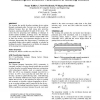Free Online Productivity Tools
i2Speak
i2Symbol
i2OCR
iTex2Img
iWeb2Print
iWeb2Shot
i2Type
iPdf2Split
iPdf2Merge
i2Bopomofo
i2Arabic
i2Style
i2Image
i2PDF
iLatex2Rtf
Sci2ools
CHI
2005
ACM
2005
ACM
Measuring the effective parameters of steering motions
The steering law model describes pointing device motion through constrained paths. Previous uses of the model are deficient because they are built using only error-free responses, ignoring altogether the path of the cursor. We correct this by proposing and validating a technique to include spatial variability, including errors. The technique is a variant of the well-known "effective target width" used in Fitts' law models. An experiment designed to test our technique demonstrates the improvement: Correlations are consistently higher when spatial variability is included in building the model. Suggestions to aid further development of the steering law model are included. Author Keywords Steering law, effective width, error rate, Fitts' law ACM Classification Keywords
CHI 2005 | Effective Target Width | Human Computer Interaction | Keywords Steering Law | Steering Law Model |
| Added | 30 Nov 2009 |
| Updated | 30 Nov 2009 |
| Type | Conference |
| Year | 2005 |
| Where | CHI |
| Authors | I. Scott MacKenzie, Sergey Kulikov, Wolfgang Stürzlinger |
Comments (0)

